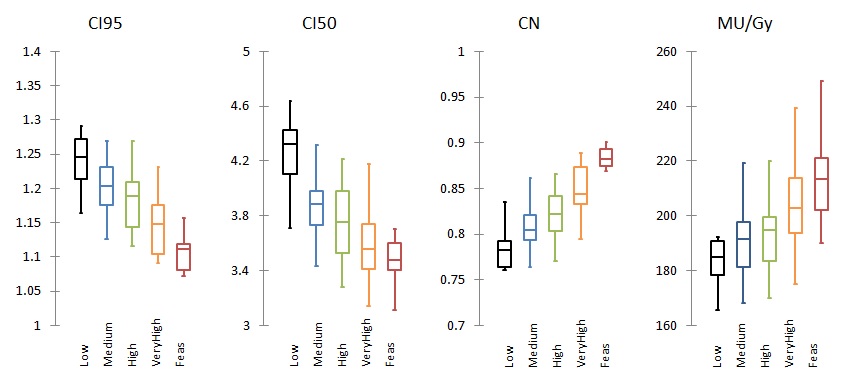Feasibility-guided automation of prostate SBRT planning: the power of DVHs a-priori knowledge
PO-1744
Abstract
Feasibility-guided automation of prostate SBRT planning: the power of DVHs a-priori knowledge
Authors: Carmela Romano1, Pietro Viola1, Maurizio Craus1, Gabriella Macchia2, Milena Ferro2, Paolo Bonome2, Luca Indovina3, Milly Buwenge4, Silvia Cammelli4, Vincenzo Valentini5, Alessio Giuseppe Morganti4, Francesco Deodato2, Savino Cilla1
1Gemelli Molise Hospital, Medical Physics Unit, Campobasso, Italy; 2Gemelli Molise Hospital, Radiation Oncology Unit, Campobasso, Italy; 3Fondazione Policlinico Universitario A. Gemelli, Medical Physics Unit, Roma, Italy; 4IRCCS Azienda Ospedaliera Universitaria di Bologna, Radiation Oncology Unit, Bologna, Italy; 5Fondazione Policlinico Universitario A. Gemelli, Radiation oncology Unit, Roma, Italy
Show Affiliations
Hide Affiliations
Purpose or Objective
Significant
improvements in plan quality using automated planning have been previously
demonstrated. The aim of this study was
to develop an optimal automated class solution for SBRT planning of prostate
cancer using the new Feasibility module implemented in the Pinnacle Evolution.
Material and Methods
Twelve patients were
retrospectively enrolled in this planning study. Five plans were designed for
each patient. Four plans were automatically generated using the four proposed
templates for SBRT optimization implemented in the new Pinnacle Evolution TPS,
differing for different settings of dose-fallout (Low, Medium, High and
VeryHigh). Based on the obtained results, the
fifth plan (Feas) was generated customizing the template with the
optimal criteria obtained from the previous step and integrating in the
template the “a-priori” knowledge of OARs sparing based on the Feasibility module,
able to estimate the best possible DVHs of OARs before starting optimization. Prescribed dose was 35 Gy to the prostate in 5
fractions. All plans were generated with a full VMAT arc and 6MV FFF beams, and
optimized to ensure the same target coverage (95% of the prescription dose to
98% of the target). OARs constraints were as follow: rectum, V18Gy<35%,
V28Gy<10% and V35Gy<5%; bladder, V18Gy<40%, V30Gy<15% and
Dmax<38 Gy; femoral heads, V25Gy<10%. Plans were assessed according to dosimetric
parameters, monitor units, and efficiency planning time. Conformity indexes at
95% and 50% dose levels and cConformation number (CN) were used for comparison.
Differences among the plans were
evaluated using a Kruskal-Wallis one-way analysis of variance.
Results
No significant differences were
found among the five techniques for prostate coverage in terms of all
dosimetric metrics (D95%, D50% and D2%). Feas plans showed consistently better
dose conformity with respect to other solutions providing a mean CN value of
0.88 (p<0.05) (Figure1). Feas plans showed significant reduction of rectum irradiation; Dmean and V18 decreased by
19-21% (p<0.05) and 6-7% (p<0.05), respectively. No statistically significant differences were
found in bladder, femoral heads and penile bulb irradiation for all dosimetric
metrics. Feas plans showed a significant increased of MU/Gy (mean: 214;
p<0.05), reflecting an increased level of fluence modulation. Thanks to the new efficient optimization
engines implemented in Pinnacle Evolution (as L-BFGS and Layered Graph), mean
planning time was decreased to only 9.5±2.4 minutes for all plans.

Conclusion
The integration of DVHs a-priori
knowledge provided by the Feasibility module in the automated planning process
for SBRT planning has shown to significantly improve plan quality compared to
generic protocol values as inputs.